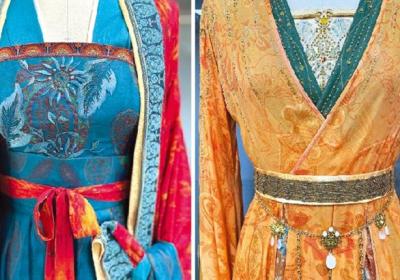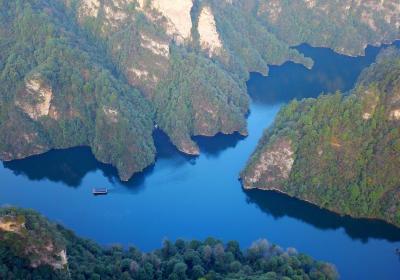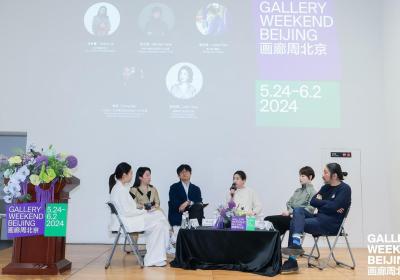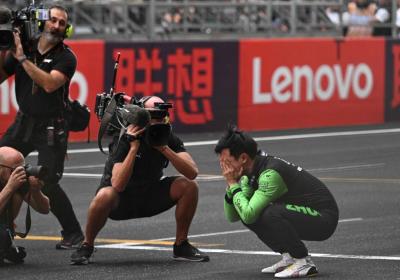Editor's note: The holding of the third Belt and Road Forum for International Cooperation will include many events including exhibitions and forums that promote people-to-people exchanges as well as mutual learning among different peoples in the world. The forum will also facilitate exchanges among international professionals, during which they will share their views about the fruitful achievements gained from the cultural exchanges with the support of the Belt and Road Initiative (BRI), and their blueprints for future communication and collaboration efforts. 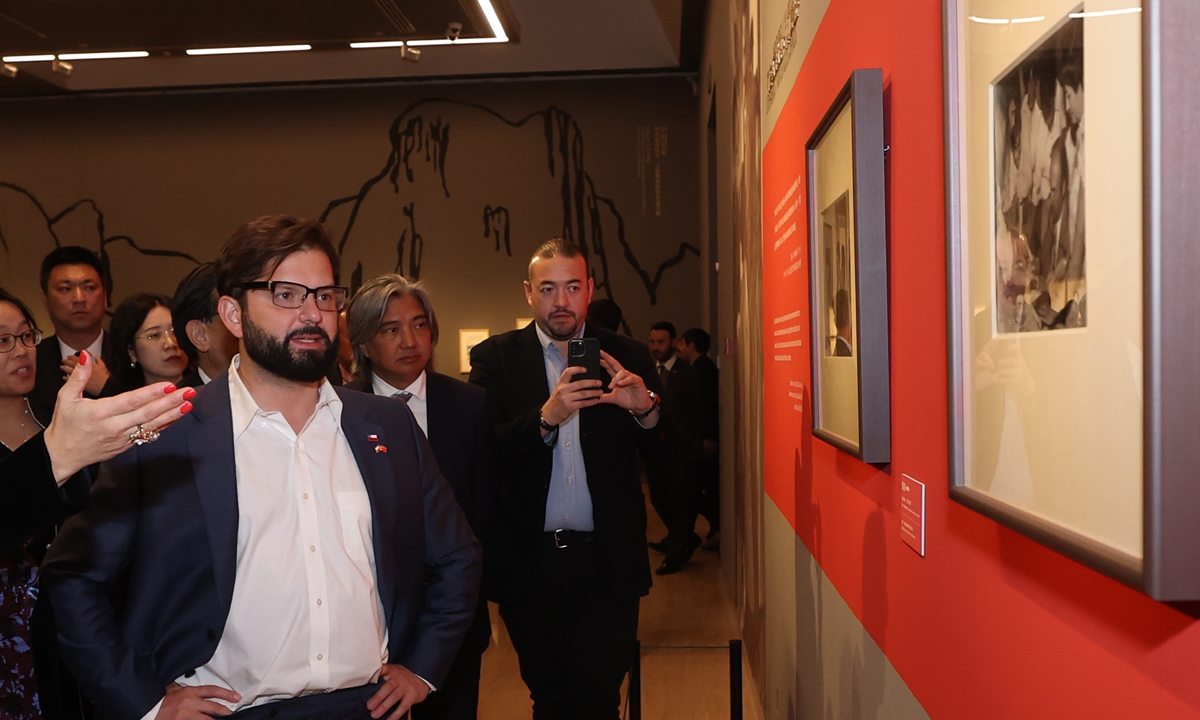
Chilean President Gabriel Boric (left) looks at a picture of Jose Venturelli in Beijing on October 16, 2023. Photo: Courtesy of the National Art Museum of China
As part of his state tour in China, Chilean President Gabriel Boric kicked off an exhibition at the National Art Museum of China on October 16 along with China's Minister of Culture and Tourism Hu Heping, paying tribute to the Chilean artist Jose Venturelli (1924-88) for his contributions to the Chile-China friendship.
"We have highlighted the pride we feel in having been the first country in South America to establish relations with China and, from there, a path was opened that we continue to broaden today and this path would surely not have been possible to open without Jose Venturelli," said Boric, adding that Venturelli was a man "who carries a message of peace to the world."
Chile joined China's Belt and Road Initiative (BRI) in 2018.
"With China, we are strategic and commercial partners and the relationship between the two countries is a matter of state. We are proud to say that this is not limited to the protocol, diplomatic, and commercial sphere, but also to art and deep in our hearts. And this is expressed very well in Venturelli's work," Boric concluded.
Venturelli, a Chilean artist, was the first Latin American painter to visit China in 1952. He participated in the founding of the Chilean-Chinese Institute of Culture and contributed to the establishment of diplomatic relations between the two countries as well as the fostering of friendship between China and Latin America.
While in China, he participated in a collective workshop at the Central Academy of Fine Arts in Beijing and befriended famous Chinese artists such as Qi Baishi, Wu Zuoren and Li Keran.
Minister Hu spoke highly of Venturelli's contributions to promoting cultural exchanges and friendly relations between the two countries and peoples.
The exhibition, titled The Chinese Memory, brings together works collected by the Jose Venturelli Foundation and paintings by famous Chinese artists collected by the National Art Museum of China, Hu said.
It realizes exchanges and dialogues across time and space between artists from the two countries, and provides a good opportunity for exchanges between China and Chile.
Artifact conservationAs an international platform for cultural heritage professionals from China and abroad to engage in exchanges and cooperation, the Taihe Forum kicked off at the Palace Museum on October 16.
The two-day forum, which included five academic reports, mainly discussed topics including the significance of international organizations in the protection of cultural heritage as well as trends in the standardization of cultural relic protection.
"Protecting cultural relics is tantamount to safeguarding our enduring cultural heritage and the spiritual homeland from which we draw our roots," Hu said, noting cultural relics' role in carrying on the history of civilizations, inheriting historical culture, and serving as witnesses to the exchanges and mutual learning among civilizations.
Greek Minister of Culture Lina Mendoni, who also participated in the forum, told the Global Times that the Taihe Forum provided Greece with an ideal opportunity to discuss the protection of cultural heritage from the impact of climate change.
The Greek government has undertaken an international initiative, in collaboration with the UN Framework Convention on Climate Change and the UN educational and cultural arm UNESCO, to which more than 100 countries and regions have already responded in a positive manner.
Participants at the forum are calling for facilitating idea exchanges on the preservation and protection of cultural heritage and examination of the possibilities of international cooperation.
"Recognizing the utmost need for close international cooperation is undoubtedly the first and most critical step toward common action against global challenges," Mendoni said.
It is reported that a total of 17 local and international professionals participated in the cultural exchange forum and shared their insights on the theme titled "International Exchange, Cooperation and Sharing in Cultural Heritage Conservation."
Juergen Vervoorst, a vice president of the International Institute for Conservation of Historic and Artistic Works, told the Global Times that he was amazed by China's ambition to build an extraordinary number of museums to showcase the country's heritage at a hitherto unprecedented scale, while terming China's investment in conservation and heritage science as being "second to none."
Terry Simioti Nyambe, a vice president of the International Council of Museums, told the Global Times that China is doing a lot to promote and protect its heritage and that the BRI, among other examples, impressed him as a shining example of China's international collaborative efforts with the countries connected to the Silk Road's history.
"I must commend the Chinese government and the Chinese people for protecting these heritages not only for themselves, but also internationally promoting connections, friendship, and unity between the states," he said.

Visitors watch paintings in a BRI-inspired art exhibition in Beijing on October 16, 2023. Photo: Courtesy of the China National Society for the Promotion of Arts and Culture
Artistic interpretation of BRI Having adopted "Five Stars Rising in the East" as its theme, a recent international art exhibition in Beijing displayed more than 3,000 BRI-inspired art pieces. Such works included a wide range of mediums including paintings, sculptures and environmental arts.
The works interpret the grand BRI theme through the depiction of different subjects such as "China's ethnic and cultural diversity," "Multicultural exchanges," as well as "the Chinese spirit and philosophy."
Under veteran Chinese oil painter Yang Feiyun's hand, a portrait vividly depicting a Muqam art master and his apprentice conveys the generation-to-generation inherence of the treasure of intangible cultural heritage unique to China's Uygur ethnic group.
The
Yellow River, Mother is a sculpture piece on display at the show that personifies China's Yellow River as a kind and loving mother who embraces her child. It represents how the Chinese people have continued to be nurtured by the Mother River.
Shi Yu, an art critic, told the Global Times that artists can find their "own footing" in interpreting the BRI concept and are allowed to freely express themselves on the subject.
"The diversity of the 3,000 art pieces can also showcase the BRI's contributions in diverse social and cultural fields," Shi told the Global Times.
Although the whole exhibition has been divided into 14 sections, its gist revolves around the symbolic meaning of one of China's most remarkable relics - the
Wuxing Chu Dongfang Li Zhongguo, also known as the Five Stars Rise in the East Favoring China.
It was a Han Dynasty (206BC-220) brocade that was found in Northwest China's Xinjiang Uygur Autonomous Region, a major stop along the ancient Silk Road. Zhongguo on the brocade refers to the "Middle Kingdom," and is believed to be the earliest textile artifact to feature the Chinese character
Zhongguo.
Yue Feng, a veteran archaeologist who witnessed the excavation of the piece, told the Global Times that the ancient brocade artifact epitomizes "China's prosperous history of cultural exchanges along the ancient Silk Road."
"Such a spirit of embracing multicultural cooperation that once happened along the ancient Silk Road has now been expanded to today's BRI to show China's openness," cultural sociologist Yao Yu told the Global Times.


